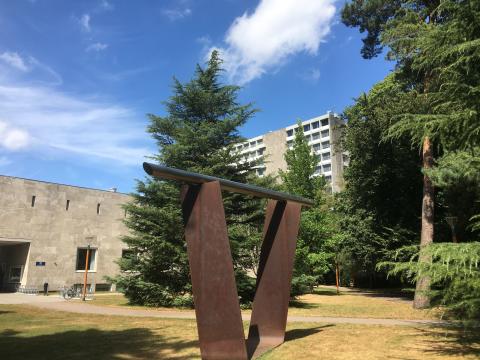Arie Berkulin
Try (1986, corten steel)
Cobbenhagen Building

In 1986, artist Arie Berkulin (1939) was commissioned to create a sculpture to mark the entrance to the current Koopmans Building. For funding, the university was able to make use of the (no longer existing) “Temporary contribution scheme provincial promotion of visual arts.”
The sculpture is made of corten steel, on which rests a stainless steel cylinder with beveled sides. It was long thought that the sculpture was called Fly, a reference to the slanted ears of an owl, which is the symbol of wisdom. However, upon inquiry in 2017, the artist indicated that the sculpture is called Try and was created as a result of the reflection on a swaying brush, slowly coming to a stop on a herring can that served as a paint tray. What does it take for something round to come to a stop on something that is straight?
This idea was elaborated by erecting the two ends of a thick strip of corten steel, 7.20 meters long and 1 meter wide. The two rising parts bend outwards, and are not exactly at right angles to the horizontal part: they make a small angle. A stainless steel cylinder has been placed on top of this, which seems to contain the deflecting forces of the two extremities, while the cylinder itself has come to a standstill. The work could be called a 'balancing act'.
Incidentally, the artwork was not long-lived at the entrance, as students immediately used it as a bicycle rack. It was a testament to administrative wisdom that the sculpture was moved two years later, to a spot sheltered by the Cobbenhagen Building.
More about history and academic heritage
The Tilburg University academic heritage is a very diverse set of archives, visual materials, collections, devices, recorded stories, et cetera that relate to the history of the university.